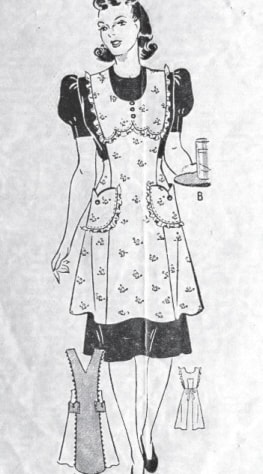As children, we surely remember tugging on our mother’s apron strings to get her attention, or searching through those deep pockets to find an extra treat or a Kleenex. For centuries, aprons of all sizes, shapes, and colors, have been the delightful symbol for mothers and daughters of the joys and toils of the daily household chores and culinary magic that bind each and every family together. Whether we would like to admit it or not, most husbands and sons have also “tied one on” to help out around the kitchen on a few occasions, and especially around the barbecue.
The history books tell us that in the early days, women of high society absolutely refused to put on an apron, but going into the 1950s all of those popular television family shows portrayed the ladies as homemakers and good mothers, who were never without their stylish and always amazingly clean and sparkling aprons.
On the other hand, aprons were not just designed for the fair sex. You need only to visit the shop of a cobbler or blacksmith to witness them honing their skills in their long and sturdy aprons, while also enjoying the tantalizing smells of leather and smoke. Of course there will always be those old reliable carpenter’s aprons every dad and craftsman possesses, proudly strap around their waists, and always stuff with many nifty gadgets for the job within its nifty compartments. While all sorts of aprons are now required to be worn on the job sites for protection and identification, brightly colored aprons or bibs with neat logos will always be popular for selling bingo cards, beer tickets, and handing out all sorts of other paraphernalia.
Most of us who are now chasing the second half of a century will readily admit our fondest memories of aprons were quite likely related to those worn around the house from morning to early evening by our precious mothers, grandmothers, and pesky sisters. I received a neat article recently outlining the history of aprons, that certainly made me feel good and maybe just a little bit melancholy, so I thought I would pass it on to you all.
• I don’t think that our present generation of kids really know what an apron is and how important and helpful it has and can still be in bringing up a family, and being well organized around the house as well as outside.
• The principal use of Grandma’s old apron was to protect the dress underneath, because she only had a few of those. It was also because it was much easier to wash out the aprons instead of the dresses and the aprons used far less and much cheaper material to make. But along with that, the old reliable apron also served as a potholder for removing hot pans from the oven.
• Aprons were also perfect for drying children’s tears and on occasion were even used for cleaning out dirty ears or wiping runny noses. The many compartments in a ladies’ apron also had to contain the vital items to take care of a sudden cut, a smudge, or a spill or whatever catastrophe may occur.
• Out in the chicken coop the apron was used for carrying eggs, coddling fussy chicks and sometimes half-hatched eggs to be rushed inside and finished in the warming oven. If the ladies were in the garden their aprons were stuffed with all sorts of vegetables and after the peas were shelled, to carry out the hulls to feed the animals. In the fall of the year the apron was perfect for bringing in apples that had fallen off the trees or to store other sweet goodies during berry picking.
• When company came those aprons were ideal hiding places for shy kids, as well as for rushing around the house and dusting in a matter of seconds, after which it was tossed into the wash box, then mother did a quick hair fluff, and no more primping was needed. We were also given strict instructions never to dare to place the following items in mother’s apron: garbage, gum, partly eaten candy, used Kleenex, or assorted pets such as frogs, hamsters or bugs.
• When dinner was ready Grandma would walk out onto the porch and wave her apron to let the men folk know to come in from the field, and if it was a really cold day she would wrap it around her arms to keep warm. Those big old aprons also wiped many a perspiring brow as they bent over a hot wood stove. They were also good for bringing in chips and kindling wood into the kitchen or living room to keep that crackling fire going.
• Dear old Grandma used to set her hot baked apple pies on the window sill to cool, while her granddaughters now set theirs on the window sill to thaw. They would also likely go crazy now worrying about how many germs might be on that apron but I don’t think we ever caught anything from that well used apron, only love and a whole lot of warmth and closeness when it was needed the most.
It will likely be a long time before someone invents something that will replace that great all purpose “old time apron” but they are still a big part of each and every household, and all one need to do is to tie one on, just to serve the role and feel the magic.
